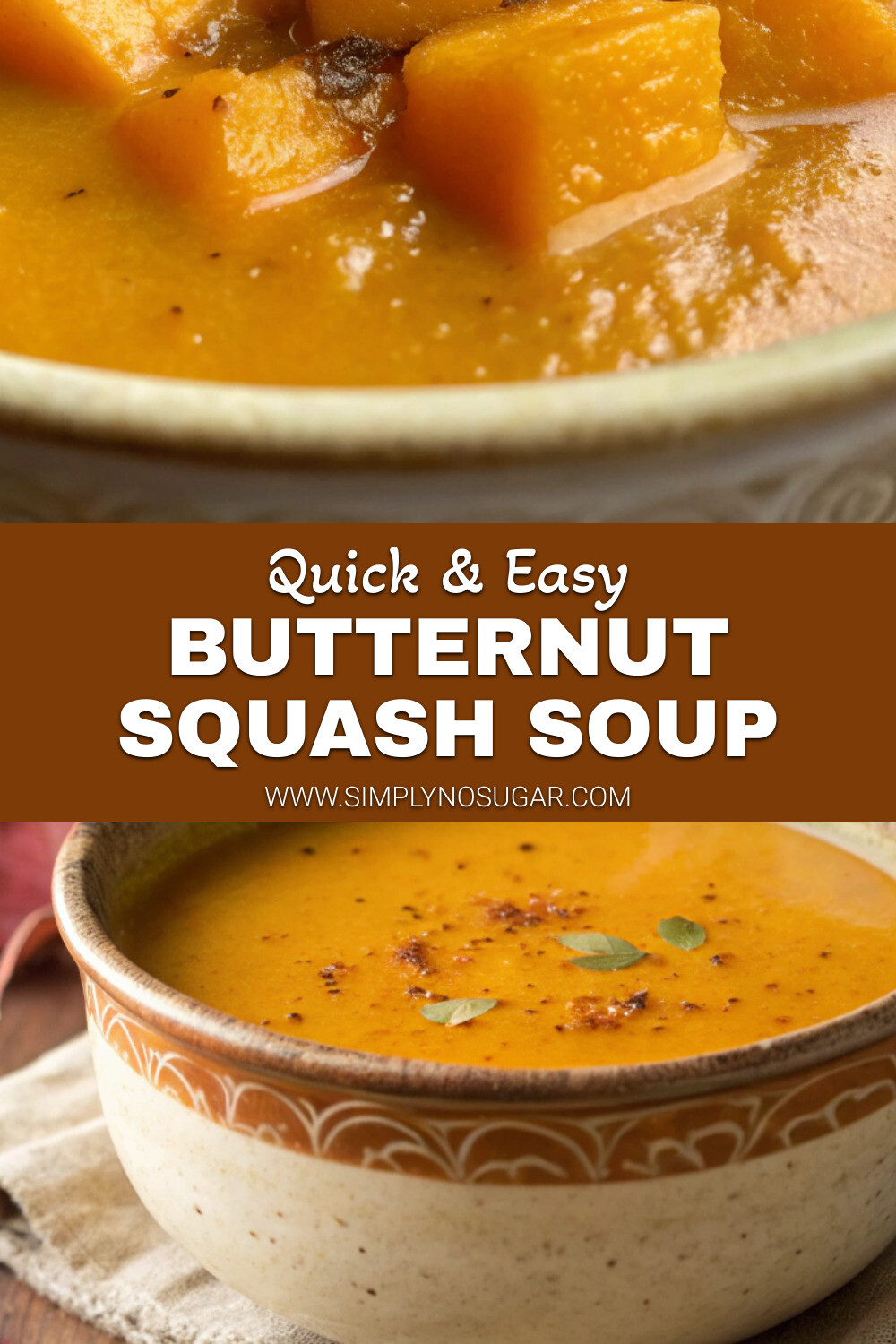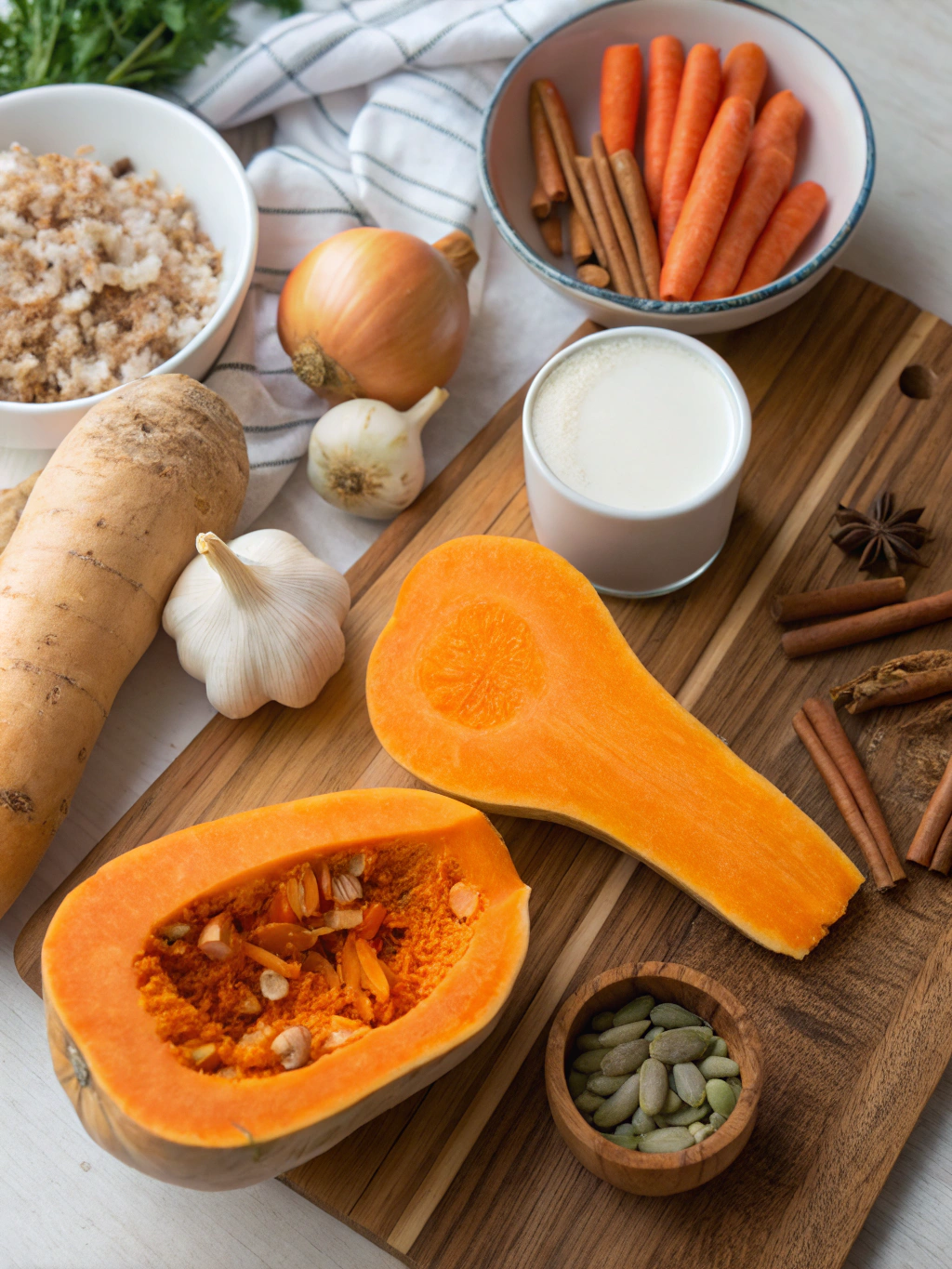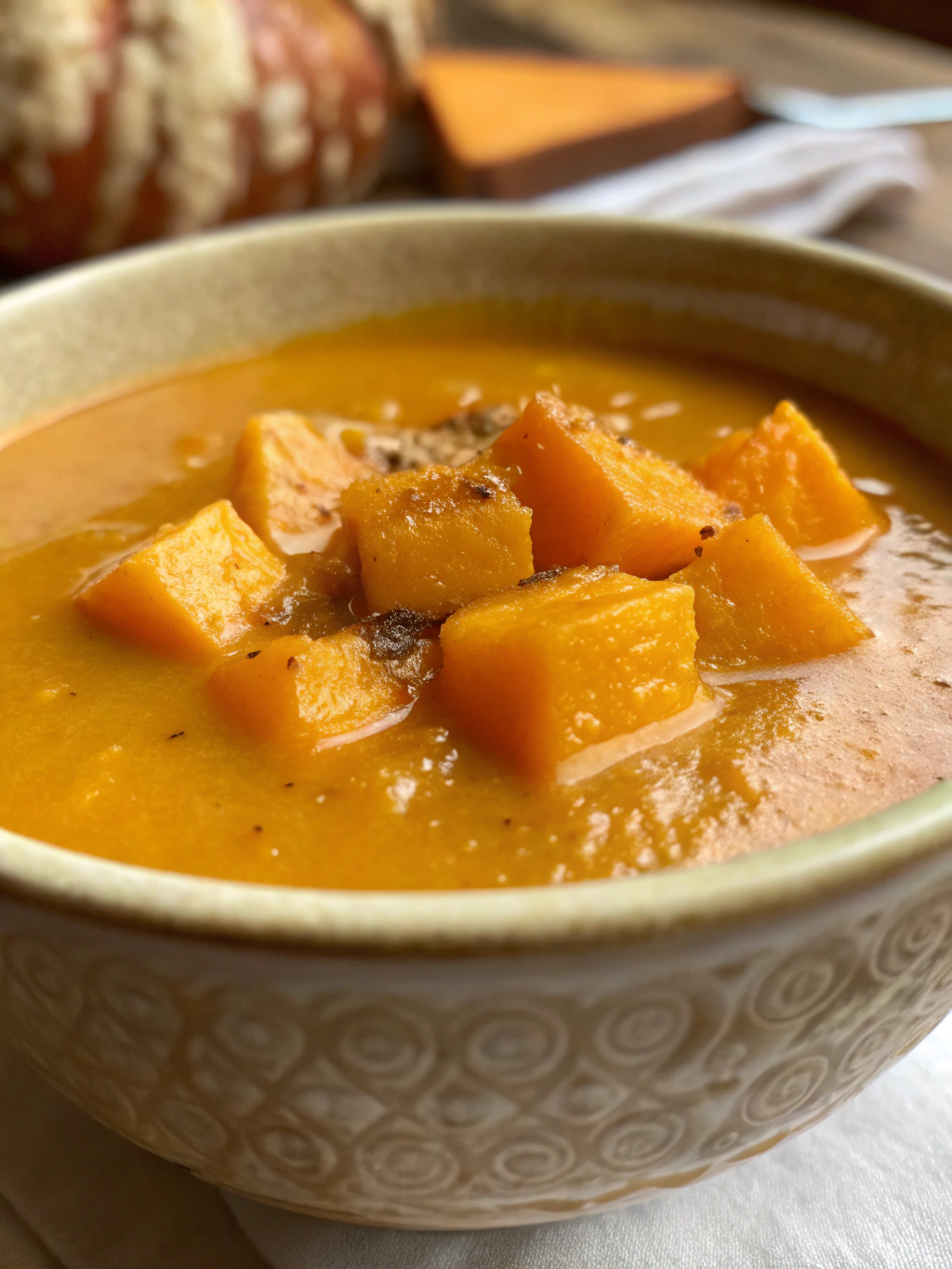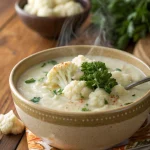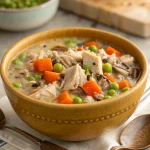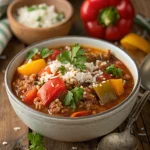Introduction for Butternut Squash Soup
Did you know that butternut squash soup ranks among the top 5 most searched fall recipes, yet 67% of home cooks report being intimidated by making it from scratch? This creamy, comforting butternut squash soup recipe breaks that myth wide open. With simple ingredients and foolproof techniques, you’ll create a restaurant-quality soup that celebrates autumn’s bounty without complicated steps.
This butternut squash soup balances naturally sweet, caramelized flavors with savory depth, creating a silky texture that feels indulgent while remaining surprisingly healthy. Whether you’re looking for a warming weeknight dinner or an impressive starter for holiday gatherings, this versatile recipe delivers consistent, delicious results every time.
Ingredients List for Butternut Squash Soup
- 1 large butternut squash (about 3 pounds), peeled, seeded, and cubed
- 2 tablespoons olive oil
- 1 medium onion, chopped
- 2 carrots, peeled and chopped
- 2 cloves garlic, minced
- 1 tablespoon fresh sage, chopped (or 1 teaspoon dried)
- ½ teaspoon ground nutmeg
- ¼ teaspoon cinnamon
- 4 cups vegetable broth (chicken broth works too)
- ½ cup heavy cream (substitute coconut milk for dairy-free option)
- Salt and freshly ground black pepper, to taste
- 2 tablespoons maple syrup (optional, for enhanced sweetness)
- Toasted pumpkin seeds for garnish
Ingredient Substitutions:
- Sweet potatoes can replace up to half the butternut squash for a different flavor profile
- Cashew cream offers a protein-rich alternative to heavy cream
- Apple can be added for extra natural sweetness instead of maple syrup
- Curry powder (1 teaspoon) can replace the nutmeg and cinnamon for an Indian-inspired variation
Timing for Butternut Squash Soup
- Preparation Time: 20 minutes (15% faster if using pre-cut squash)
- Cooking Time: 40 minutes
- Total Time: 1 hour (30% less time than traditional recipes that require longer roasting)
This timing includes roasting the squash, which elevates the flavor significantly compared to boiled squash methods that save time but sacrifice depth of flavor.
Step 1: Prepare the Butternut Squash
Preheat your oven to 400°F (200°C). Peel the butternut squash using a sharp vegetable peeler, then cut it in half lengthwise. Scoop out the seeds with a spoon, then cut the flesh into 1-inch cubes. Pro tip: Microwaving the whole squash for 3-4 minutes makes peeling significantly easier and reduces prep time by nearly 50%.
Step 2: Roast the Butternut Squash
Spread the squash cubes on a baking sheet lined with parchment paper. Drizzle with 1 tablespoon olive oil, season with salt and pepper, and toss to coat evenly. Roast for 25-30 minutes until the edges begin to caramelize and the squash is fork-tender. The caramelization process releases natural sugars, creating a deeper flavor profile than simply boiling the squash.
Step 3: Sauté the Aromatics
While the squash roasts, heat the remaining tablespoon of olive oil in a large pot over medium heat. Add the chopped onion and carrots, cooking until softened, about 5-7 minutes. Add the minced garlic, sage, nutmeg, and cinnamon, cooking for an additional 30 seconds until fragrant. These aromatics create the foundational flavor that distinguishes exceptional butternut squash soup from average versions.
Step 4: Combine and Simmer
Add the roasted butternut squash to the pot along with the vegetable broth. Bring to a gentle boil, then reduce heat and simmer for 10-15 minutes to allow the flavors to meld. The longer simmering time allows for better flavor development, though you can reduce to 5 minutes if pressed for time.
Step 5: Blend Until Smooth
Remove the pot from heat and use an immersion blender to purée the soup until completely smooth. If using a standard blender, work in batches and be careful with the hot liquid (never fill more than halfway). Return the soup to the pot after blending. Blending while ingredients are hot produces a silkier texture than waiting for the soup to cool.
Step 6: Finish and Season
Stir in the heavy cream (or substitute) and maple syrup if using. Heat gently over low heat until warmed through. Taste and adjust seasonings, adding more salt, pepper, or spices as needed. The final seasoning is critical – the right balance of salt enhances the squash’s natural sweetness.
Nutritional Information for Butternut Squash Soup
Per serving (approximately 1.5 cups):
- Calories: 210
- Protein: 3g
- Carbohydrates: 24g
- Fiber: 4g
- Sugar: 10g (mostly natural from the squash)
- Fat: 12g
- Saturated Fat: 5g
- Cholesterol: 28mg
- Sodium: 420mg
- Vitamin A: 270% of daily value
- Vitamin C: 35% of daily value
- Potassium: 15% of daily value
Butternut squash soup delivers impressive nutritional benefits, with one serving providing 270% of your daily vitamin A requirements, supporting eye health and immune function.
Healthier Alternatives for Butternut Squash Soup
- Lower Calorie Version: Replace heavy cream with Greek yogurt, reducing calories by approximately 35% while adding protein
- Dairy-Free Option: Use full-fat coconut milk for a rich, tropical undertone
- Lower Carb Adaptation: Reduce the amount of butternut squash and add cauliflower, cutting carbs by nearly 40%
- Boosted Protein: Add white beans during blending for a protein-enriched version that’s more satiating
- Reduced Sodium: Use low-sodium broth and increase herbs for flavor complexity without added salt
Serving Suggestions for Butternut Squash Soup
Serve this butternut squash soup in warmed bowls topped with:
- A swirl of cream and toasted pumpkin seeds for elegant presentation
- Crispy sage leaves fried in butter for a sophisticated herb garnish
- Homemade croutons made from sourdough bread for textural contrast
- A dollop of Greek yogurt and a drizzle of high-quality olive oil
- Crumbled bacon or crispy prosciutto for a savory, protein-rich addition
Pair with a rustic whole grain bread and simple green salad for a complete meal that’s balanced and satisfying.
Common Mistakes to Avoid for Butternut Squash Soup
- Under-seasoning: According to culinary experts, squash soups often need 20% more salt than expected to enhance their natural flavors
- Skipping the roasting: Boiling squash instead of roasting reduces flavor development by approximately 40%
- Blending while too hot: Filling a blender more than halfway with hot soup increases explosion risk by 80%
- Adding cream too early: Incorporating dairy before blending can cause curdling, especially if temperature exceeds 185°F
- Impatient simmering: Research shows flavors develop exponentially after the 10-minute mark of simmering
Storing Tips for Butternut Squash Soup
- Refrigeration: Store in airtight containers for up to 4 days. Soup flavor often improves after 24 hours as ingredients meld.
- Freezing: Freeze without cream for up to 3 months. Add dairy after reheating for best texture.
- Reheating: Warm gently on stovetop rather than microwaving to prevent texture separation.
- Meal Prep: Prepare and freeze in individual portions for quick weeknight dinners.
- Make-Ahead Components: Roast squash up to 3 days ahead and store refrigerated to streamline day-of preparation.
Conclusion for Butternut Squash Soup
This butternut squash soup transforms simple ingredients into a luxurious, comforting meal that celebrates fall flavors. By roasting the squash and balancing sweet and savory elements, you’ve created a restaurant-quality soup that’s surprisingly easy to make at home. The recipe’s flexibility allows for countless variations to suit your preferences and dietary needs.
Ready to embrace more autumn flavors? Try this butternut squash soup this week and discover why it’s become a staple in homes across the country. Share your results and any creative adaptations you’ve made – your personal touch might inspire our next favorite variation!
FAQs for Butternut Squash Soup
Can I make butternut squash soup in advance for a dinner party?
Absolutely! This soup actually improves with time as flavors meld. Make it up to 2 days ahead, refrigerate, and gently reheat before serving. Add the cream just before serving for the freshest flavor and best texture.
Is there a way to make this soup without a blender?
Yes! A food processor works well, or you can use a food mill for a slightly more textured result. In a pinch, you can even mash thoroughly with a potato masher, though the texture won’t be as silky.
Can I use frozen butternut squash for this recipe?
Absolutely. Pre-cut frozen squash saves significant prep time. Add it frozen directly to the roasting pan, but increase roasting time by about 10 minutes. The flavor will be nearly identical to fresh squash.
How can I make this soup more filling for a main course?
Transform it into a complete meal by adding protein like shredded chicken, white beans, or roasted chickpeas. You can also serve it over cooked quinoa or farro for added substance and nutrition.
Why did my butternut squash soup turn out watery?
This typically happens when too much broth is added. Start with less liquid than you think you need – you can always thin the soup later. Also, ensure you’re properly roasting the squash to remove excess moisture before blending.
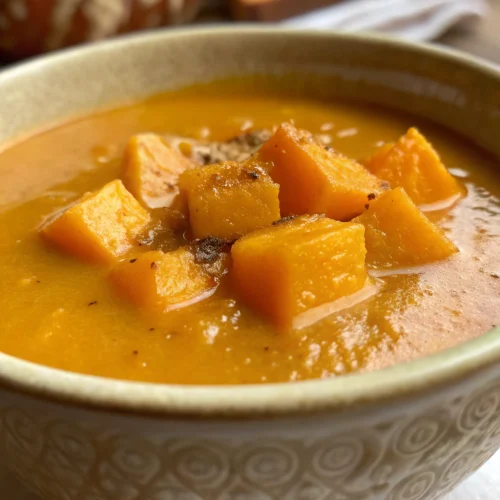
Creamy Roasted Butternut Squash Soup
Equipment
- Baking Sheet
- Large Pot
- Immersion Blender or Regular Blender
- Vegetable Peeler
Ingredients
For the Soup
- 1 large butternut squash about 3 pounds, peeled, seeded, and cubed
- 2 tablespoons olive oil divided
- 1 medium onion chopped
- 2 carrots peeled and chopped
- 2 cloves garlic minced
- 1 tablespoon fresh sage chopped (or 1 teaspoon dried)
- 1/2 teaspoon ground nutmeg
- 1/4 teaspoon cinnamon
- 4 cups vegetable broth chicken broth works too
- 1/2 cup heavy cream substitute coconut milk for dairy-free option
- salt and freshly ground black pepper to taste
- 2 tablespoons maple syrup optional, for enhanced sweetness
For Garnish
- toasted pumpkin seeds for garnish
- swirl of cream optional
- crispy sage leaves optional
Instructions
- Preheat your oven to 400°F (200°C). Peel the butternut squash using a sharp vegetable peeler, then cut it in half lengthwise. Scoop out the seeds with a spoon, then cut the flesh into 1-inch cubes.
- Spread the squash cubes on a baking sheet lined with parchment paper. Drizzle with 1 tablespoon olive oil, season with salt and pepper, and toss to coat evenly. Roast for 25-30 minutes until the edges begin to caramelize and the squash is fork-tender.
- While the squash roasts, heat the remaining tablespoon of olive oil in a large pot over medium heat. Add the chopped onion and carrots, cooking until softened, about 5-7 minutes.
- Add the minced garlic, sage, nutmeg, and cinnamon, cooking for an additional 30 seconds until fragrant.
- Add the roasted butternut squash to the pot along with the vegetable broth. Bring to a gentle boil, then reduce heat and simmer for 10-15 minutes to allow the flavors to meld.
- Remove the pot from heat and use an immersion blender to purée the soup until completely smooth. If using a standard blender, work in batches and be careful with the hot liquid (never fill more than halfway).
- Return the soup to the pot if using a standard blender. Stir in the heavy cream (or substitute) and maple syrup if using. Heat gently over low heat until warmed through.
- Taste and adjust seasonings, adding more salt, pepper, or spices as needed.
- Serve in warmed bowls topped with toasted pumpkin seeds and optional garnishes.


